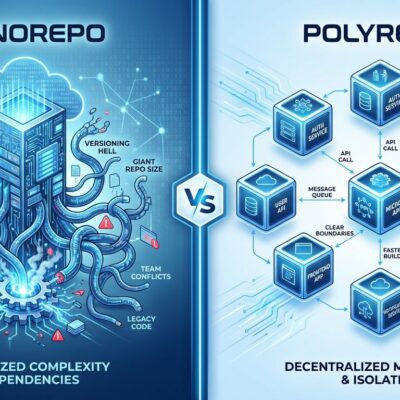
The serverless computing promise sounds compelling: pay only for what you use, zero infrastructure management, infinite scaling. But the math tells a different story. For applications with consistent traffic, serverless platforms like AWS Lambda and Vercel can cost 5-10x more than traditional servers, while introducing complexity that makes distributed systems feel simple. The “pay per execution” model that sounds economical actually penalizes the most common workload pattern—steady, predictable traffic—through per-request fees, cold start penalties, and a maze of auxiliary charges that turn $50/month workloads into $500/month surprises.
The Math Cloud Providers Don’t Show You
Consider a straightforward REST API handling one million requests per month. On AWS Lambda, you’ll pay $0.20 for the requests themselves, $417 for compute time (assuming 200ms execution at 128MB memory), $3.50 for API Gateway, $0.45 for data transfer, and $0.50 for CloudWatch logs. That’s $422 per month.
The same workload runs on a DigitalOcean VPS with 2 vCPUs and 4GB RAM for $24 per month, including 1TB of bandwidth. That’s a 17.5x cost difference for identical traffic. The incremental nature of serverless billing—fractions of cents per request—obscures the aggregate cost until bills arrive. By then, you’re locked into an architecture that’s expensive to migrate away from.
The per-request pricing model particularly punishes consistent baseline traffic, which is exactly what most web APIs serve. A function that handles requests steadily throughout the day gets charged thousands of times for work that a $24 server handles without blinking. Serverless provides the least value precisely where most applications need it most.
The Complexity Tax Beyond the Bill
Direct costs tell only half the story. Serverless introduces operational complexity that traditional servers sidestep entirely. Distributed debugging requires expensive tracing systems like Datadog or New Relic—each adding separate line items to your bill for every log line, trace, and metric. Local development becomes an exercise in mocking cloud services or running costly staging environments. Vendor lock-in through proprietary APIs like AWS Step Functions means migration becomes a complete rewrite, not a straightforward port.
Cold starts create user-facing latency ranging from 100 milliseconds to three seconds, depending on runtime and dependencies. Teams respond by purchasing “provisioned concurrency” to keep functions warm, which defeats the entire “pay only for use” premise by charging for idle capacity—essentially paying for a server you don’t control. VPC-enabled Lambda functions accessing RDS databases historically suffered 10+ second cold starts. Testing requires complex mocking setups that break on every AWS SDK update.
The serverless framework ecosystem exists precisely because managing serverless is complex enough to require orchestration tools. You’ve traded infrastructure complexity for architectural complexity, and the latter is often harder to debug. Tracing a request through 50+ Lambda functions beats troubleshooting a monolith on difficulty, cost, and engineering time every time.
When Serverless Actually Makes Sense
Serverless has legitimate use cases where the economics work. Event-driven workloads with unpredictable spikes—image processing on upload, webhook handlers, viral content spikes—genuinely benefit from instant scaling and true pay-per-use. Side projects under free tier limits get infrastructure for effectively zero cost and zero management. Scheduled batch jobs that run briefly once per day don’t justify a 24/7 server.
The key criterion is traffic intermittency, not volume. An image processing service handling 1,000 uploads per day, each triggering a 30-second Lambda function, runs 8.3 hours per month of compute time. That’s far cheaper than a dedicated server. The same service handling uploads constantly throughout the day? Traditional server wins decisively.
Yan Cui, an AWS Serverless Hero, puts it plainly: “Serverless is not always cheaper. For consistent workloads, a t3.micro can handle what would cost hundreds in Lambda. But for spiky, unpredictable loads, serverless wins every time.” The problem isn’t serverless itself—it’s the “serverless-first” dogma that ignores workload characteristics. Consider exploring Cloudflare Workers for an alternative serverless model with better economics for certain use cases.
Related: Dead Framework Theory: Why Your Tech Stack Keeps Dying
Why Companies Are Leaving the Cloud
37signals, the company behind Basecamp and HEY, documented over $7 million in savings over five years by moving from AWS to owned hardware in data centers. David Heinemeier Hansson wrote: “We’re spending about $3.2 million per year on cloud with AWS and other services. We could run the same services ourselves on hardware that would cost us about $600,000 per year—a savings of $2.6 million.” The actual savings exceeded initial estimates.
Dropbox saved $75 million over two years by migrating from AWS S3 to their own storage infrastructure. These aren’t small startups making rash decisions—they’re successful companies with sophisticated engineering teams who ran the numbers and found better economics elsewhere. A quieter trend sees companies migrating to European providers like Hetzner and OVH, where costs run a fraction of AWS rates, or adopting hybrid architectures that use cloud for burst capacity but own infrastructure for baseline loads.
The cloud repatriation movement represents industry maturation. After a decade of “cloud everything,” companies are discovering when cloud makes sense versus when it’s an expensive default driven by vendor marketing rather than economic reality.
Making Smarter Architecture Decisions
Run the cost calculations before adopting serverless, not after the bill arrives. Use AWS pricing calculators with realistic traffic projections, then multiply by three because you’re probably underestimating. Compare against a simple VPS or container setup with comparable resources. Factor in the complexity tax: debugging tools, monitoring platforms, engineering time spent fighting distributed system problems.
The decision tree is straightforward. Intermittent, spiky traffic patterns favor serverless because you truly pay only for active compute time. Consistent baseline traffic with predictable patterns favors traditional servers or containers because fixed monthly costs beat per-request billing. If you’re adopting serverless “because everyone else is” or “because it’s modern,” stop and reconsider.
Corey Quinn, AWS cost expert and founder of The Duckbill Group, nails the core issue: “The serverless promise is ‘you only pay for what you use.’ The reality is you pay for what you provision, and you over-provision because you’re terrified of cold starts.” You’re paying serverless prices while solving server-like problems with expensive band-aids.
Key Takeaways
- Serverless costs scale 5-10x higher than traditional servers for applications with consistent traffic—run the math with AWS pricing calculators before committing to the architecture.
- The complexity tax extends beyond direct costs: distributed debugging, cold start workarounds, vendor lock-in, and specialized monitoring tools add engineering time and tool costs.
- Serverless genuinely wins for event-driven, intermittent workloads—image processing, webhooks, cron jobs, and traffic spikes where you pay only for actual compute time.
- The cloud repatriation movement (37signals, Dropbox) validates that questioning serverless economics isn’t contrarian—it’s financially sound for consistent workloads.
- Evaluate based on traffic patterns, not industry hype: intermittent and spiky favors serverless, consistent baseline favors traditional servers or containers.
Boring, reliable, cheap servers running predictable workloads might be exactly the right architectural choice. The smart money evaluates economics and workload characteristics rather than following “serverless-first” dogma.










